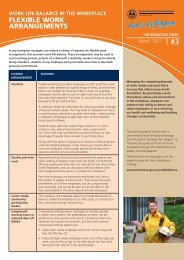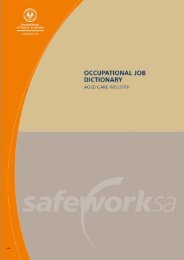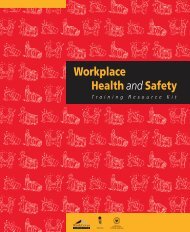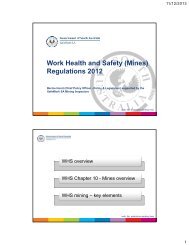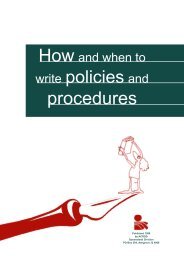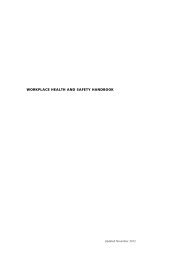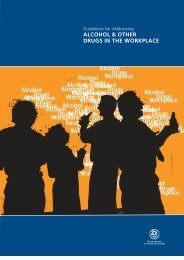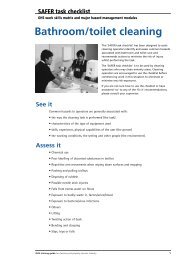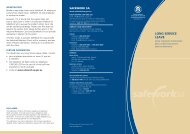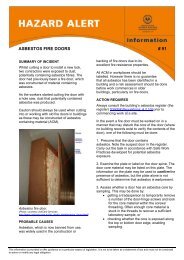Hospitality Industry Occupational Job Dictionary ... - SafeWork SA
Hospitality Industry Occupational Job Dictionary ... - SafeWork SA
Hospitality Industry Occupational Job Dictionary ... - SafeWork SA
You also want an ePaper? Increase the reach of your titles
YUMPU automatically turns print PDFs into web optimized ePapers that Google loves.
4 – CARVERY CHEF - BISTRO (photograph 8)<br />
The carvery chef is required to stand at the buffet<br />
in the bistro area for the meal serving period. They<br />
are required to carve meat for customers, top up salads<br />
and vegetables and keep the buffet area clean. This<br />
task requires bilateral upper limb usage to stabilise<br />
the meat and carve with dominant upper limb.<br />
Cylindrical grasping is required to use knives and<br />
other required equipment. This task is done while<br />
standing and involves slight stooping and neck flexion<br />
to view the food for preparation at the bench located<br />
at waist height. Shoulder flexion/extension is required<br />
to cut the meat and slight forward stooping to access<br />
the areas of the buffet.<br />
RECOMMENDATIONS<br />
CHEF (Large venues)<br />
1. Anti-fatigue and anti-slip mats can be purchased from hospitality equipment suppliers and used in the kitchen<br />
areas. These mats soften the ground surface and provide cushioning to reduce static muscle loading on the lower<br />
limb girdle caused by prolonged standing on hard surfaces and provide a non-slip surface to reduce risk of falls.<br />
2. Frequently used goods, heavier items and frequently used utensils should be stored between waist to chest<br />
height. Overhead storage and ground level storage should be utilised to store light goods/items or goods/items<br />
used on an occasional basis only.<br />
3. Boxes and goods in freezers and storage areas should be arranged so that staff members can access them<br />
as close as possible, avoiding stooping postures and over-reaching when lifting.<br />
4. Kick or step stools should be utilised by staff in order to reduce overhead reaching requirements in store<br />
room areas.<br />
5. Workers may benefit from the use of correct work postures. Back care education and lifting/handling principles<br />
could be reinforced:<br />
a) lifting to be conducted with feet at least shoulder-width apart<br />
b) carry, push/pull to be conducted with load as close to the body as possible, with neutral shoulders and<br />
semi-flexed elbows<br />
c) workers to complete correct foot work for push/pull or lift including feet facing in direction of movement<br />
to avoid twisting<br />
d) lifting to be conducted with squat postures, to avoid back stooping<br />
e) avoid stooping postures by re-designing the workstation or squatting when necessary<br />
f) avoid over-reaching postures by redesigning the work area or the techniques used, so that the shoulders<br />
can maintain a neutral to semi-flexed position.<br />
6. Pre-employment evaluations may be beneficial to be conducted for all new employees, to ensure potential<br />
employees have the physical capacities to meet the physical demands of the job. They will assist in eliminating<br />
potential risk of re-aggravation following commencement of work. Thus pre-existing conditions could surface<br />
whilst performing this assessment.<br />
7. Ergonomic knives are available that allow the arm, wrist and hand to maintain a natural and neutral position<br />
and reduces effort required for standard knives. These can be acquired for people with wrist conditions.<br />
OCCUPATIONAL JOB DICTIONARY - HOSPITALITY INDUSTRY - HOTELS AND MOTELS 109<br />
8



